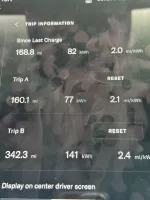I’m impressed with that the size of the battery pack allows resilience in adverse conditions: low temperatures, steep terrain and high winds….An example to share would be driving from just north of Phoenix, around the NW loop and connecting to Interstate 8. We left the charging station in Anthem and due to posted speeds and traffic, we set the HWA at 70mph. The Temperature was 69 and for just over 100 miles, we logged 4.4 miles/KWh. (This is the number that will give the approximate 512 mile range) After merging on I-8 and setting the HWA at 75, the Miles/kWh stabilized at 4.0 (temperature still at 69) until we climbed the Chocolate Mountains just outside of Yuma….the Miles/KWh dropped to 3.8. We charged a bit in Yuma while stretching an walking, had a latte at Starbucks and then drove from below sea level to over 4,000’ to get back home in San Diego County…the miles/kWh dropped to 3.2. My observation is that the sweet spot for EPA class mileage is a temperature of 69 and a speed of 70, driving with very even inputs for steering, braking and acceleration helps.
Again, I am glad that with much lower temperatures steep topography and faster speeds, the battery’s size allows very a respectable range. I like to have the % showing on the dash rather than the miles remaining(% is an option) and I like to open on the Pilot Panel the “Vehicle” on the settings, and the Trip option on the Vehicle heading. The first line shows the current mileage since last charge and the running “Miles/KWh”. Much easier to estimate remaining miles with % and miles/KWh.
Yesterday while driving for Dr appointment and errands I logged 4.7 miles/KWh over a 60 mile distance.I left home at 1,800‘ and drove downhill and at 60 miles of driving had the 4.7 number….by the time I got home it dropped to 4.0…..

